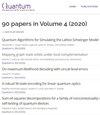Shadows and subsystems of generalized probabilistic theories: when tomographic incompleteness is not a loophole for contextuality proofs
IF 5.1
2区 物理与天体物理
Q1 PHYSICS, MULTIDISCIPLINARY
引用次数: 0
Abstract
It is commonly believed that failures of tomographic completeness undermine assessments of nonclassicality in noncontextuality experiments. In this work, we study how such failures can indeed lead to mistaken assessments of nonclassicality. We then show that proofs of the failure of noncontextuality are robust to a very broad class of failures of tomographic completeness, including the kinds of failures that are likely to occur in real experiments. We do so by showing that such proofs actually rely on a much weaker assumption that we term $\textit{relative tomographic completeness}$: namely, that one's experimental procedures are tomographic $\textit{for each other}$. Thus, the failure of noncontextuality can be established even with coarse-grained, effective, emergent, or virtual degrees of freedom. This also implies that the existence of a deeper theory of nature (beyond that being probed in one's experiment) does not in and of itself pose any challenge to proofs of nonclassicality. To prove these results, we first introduce a number of useful new concepts within the framework of generalized probabilistic theories (GPTs). Most notably, we introduce the notion of a GPT $subsystem$, generalizing a range of preexisting notions of subsystems (including those arising from tensor products, direct sums, decoherence processes, virtual encodings, and more). We also introduce the notion of a $shadow$ of a GPT fragment, which captures the information lost when one's states and effects are unknowingly not tomographic for one another.广义概率理论的阴影和子系统:当层析不完备不是上下文证明的漏洞时
人们普遍认为,层析完整性的失败破坏了非情境性实验中对非经典性的评估。在这项工作中,我们研究了这些失败是如何导致对非经典性的错误评估的。然后我们表明,非情境性失败的证明对于层析完整性的非常广泛的失败类别是稳健的,包括可能在实际实验中发生的失败类型。我们这样做是为了证明这些证据实际上依赖于一个更弱的假设,我们称之为$\textit{relative tomographic completeness}$:也就是说,一个人的实验过程是层析的$\textit{for each other}$。因此,即使使用粗粒度的、有效的、紧急的或虚拟的自由度,也可以确定非上下文性的失败。这也意味着,一个更深层次的自然理论的存在(超出了在一个人的实验中所探索的)本身并不会对非经典性的证明构成任何挑战。为了证明这些结果,我们首先在广义概率论(GPTs)的框架内引入了一些有用的新概念。最值得注意的是,我们引入了GPT $subsystem$的概念,推广了一系列预先存在的子系统概念(包括由张量积、直接和、退相干过程、虚拟编码等产生的概念)。我们还引入了GPT片段$shadow$的概念,它捕获了当一个人的状态和效果在不知不觉中没有相互断层扫描时丢失的信息。
本文章由计算机程序翻译,如有差异,请以英文原文为准。
求助全文
约1分钟内获得全文
求助全文
来源期刊

Quantum
Physics and Astronomy-Physics and Astronomy (miscellaneous)
CiteScore
9.20
自引率
10.90%
发文量
241
审稿时长
16 weeks
期刊介绍:
Quantum is an open-access peer-reviewed journal for quantum science and related fields. Quantum is non-profit and community-run: an effort by researchers and for researchers to make science more open and publishing more transparent and efficient.
 求助内容:
求助内容: 应助结果提醒方式:
应助结果提醒方式:


